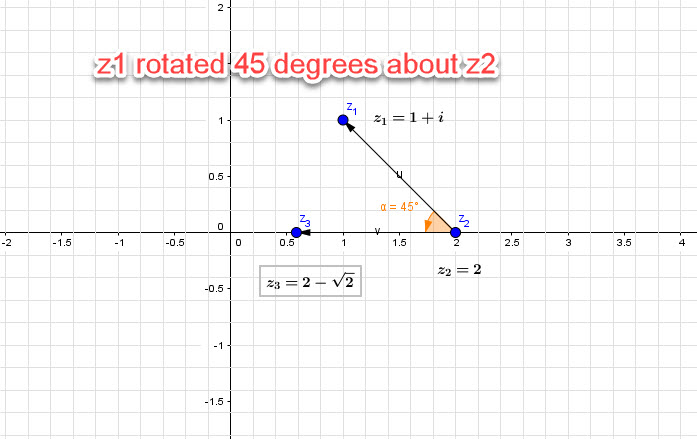Complex numbers and transformations
A transformation on the plane maps each point ![]() to its image
to its image ![]() .
.
We can then associate each point to its affix. Let’s call these affixes ![]() and
and ![]() , two complex numbers.
, two complex numbers.
We can now write the transformation in complex terms:
![]() where
where ![]() is the complex function associating
is the complex function associating ![]() to
to ![]()
Translation
For a vector ![]() we have an affix
we have an affix ![]() .
.
We can simply write that:
![]()
This simplifies to adding two vectors.
Let’s consider a point ![]() with affix
with affix ![]()
Now let’s translate it using ![]() .This is the same as adding it to the complex
.This is the same as adding it to the complex ![]()
We get another point ![]() which is the image of
which is the image of ![]() with affix
with affix ![]()
![]()
![]()
This can be used as a ship’s speed moving it along its course. Very solid concept.
Rotation from a complex number point of view
The Rotation must be centered at the origin ![]() . If
. If ![]() is the angle of rotation:
is the angle of rotation:
The image of ![]() is
is
![]()
This was the easiest case. Now, let’s take another center of rotation ![]() with an affix
with an affix ![]() .
.
The idea is to move the center of rotation to the origin ![]() .This is a simple translation by adding
.This is a simple translation by adding ![]() first and then make the rotation and finally add
first and then make the rotation and finally add ![]() to take the point to its original position.
to take the point to its original position.
![]()
Example:
Simple rotation about 
A point ![]() with affix
with affix ![]() is rotated about the origin by
is rotated about the origin by ![]() , find the point
, find the point ![]() of affix
of affix ![]() , image of
, image of ![]() after rotation.
after rotation.
![]() ,
, ![]() is the base angle.
is the base angle.
In exponent expression:
![]()
We use the rotation formula:
![]()
![]()
Rotation about any point
Now let’s rotate the point ![]() with affix
with affix ![]() about another point A point
about another point A point ![]() with affix
with affix ![]() by
by ![]()
we use our formula:
![]()
![]()
We can see that the resulting image:
![]() ,
, ![]() is the base angle.
is the base angle.
![]()
This is the final image



Be the first to comment